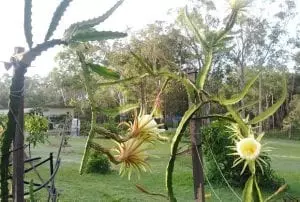Are you worried about the rising cost of food? Or even worse, a food crisis? We’ve seen unprecedented pressure on our food supply these past couple of years- things like extreme weather events, a shortage of fertiliser, logistical delays, rising energy prices and even a lack of fruit & veggie pickers are affecting us like never before. And let’s not delve into the topic of inflation- suffice to say we all know that all kinds of prices are rising sharply, no matter where you live.

All this is enough to drive you bananas! So if we can’t rely on governments and big corporations to assure our food supply –and we can’t– then we must take steps on an individual level to buffer ourselves against hard times.
To that end, here are my 6 top crops that you can grow at home to save from starving. I’ve put a lot of thought into these choices, based on several criteria. They had to be easily grown at home in an average-sized yard, give a good harvest for the growing space used, have good preserving qualities, and of course have high sustenance value as a food.

Potatoes
The key to growing potatoes is diversity. These days there are lots of varieties available & they have pretty good disease resistance. Planting different varieties at the same time and from year to year further limits a build-up of pests & disease. If you live in the subtropics like I do, check out our detailed guide to potato growing in the subtropics.
Speaking of diversity, potatoes can be grown in a variety of ways. These include directly in ground, hilled up in trenches, in old compost bins, boxes or containers. There’s a way to grow potatoes that suits just about every climate, every budget & every size of property.
Potatoes have historically been a food staple (think of what happened in Ireland during the potato famine), yet these days are usually a side dish. Potatoes are versatile in the kitchen & contain a variety of vitamins and minerals, so there’s no reason for them not to be a staple during tough times.

Corn
Corn is one of the 3 biggest plant-based food sources in the world (rice & wheat are the others). During the Irish potato famine, the USA sent tonnes of corn to Ireland in order to help the starving population. Unlike rice & wheat, corn can be grown effectively on a small scale & still produce a lot of food, so it’s ideal for the home gardener.
Corn has a compact & upright growth habit. It can be interplanted with beans, squash and/or a variety of low-growing crops, which makes it doubly space-efficient in the garden. Corn is a fast grower and copes well with hot weather, so it’s a great staple for warm climate gardeners.
Home-grown corn can be cooked & eaten in a huge variety of ways. Many of us enjoy eating it on the cob, but you can get creative with it too, & make your own flour, grits, tortillas and popcorn. Once your corn has been harvested, you can even make use of the spent plant by chipping it & recycling it back into the garden as a nutritious mulch.

Cabbage
Cabbage is exceptionally high in nutrients and has a myriad of health benefits. It has been said to boost the immune system, aid muscle function, lower blood pressure, & reduce inflammation.
Cabbage grows relatively quickly, and I personally think it’s amazing how the heads become so tight & juicy within a short space of time. This is a vegetable that is easy to grow in the home garden and produces a large amount of food. The only potential issue is cabbage moths. In this case you can simply net your plants to prevent damage. As cabbage plants don’t need to be pollinated & don’t have long stalks that can be damaged, netting is an easy job.
Cabbage goes a long way towards feeding a family: it can be used to bulk up a stew, shredded then fried on its own as a side dish or used raw in a slaw. It’s easy to preserve, too- you can freeze it, freeze-dry it, or ferment it to make tasty foods like sauerkraut & kimchi.

Pumpkin
There are few easier tasks in the garden than sowing a few pumpkin seeds. In fact, the whole process of growing pumpkin is very easy. Once your seedlings pop up, just let the plants grow on, then meander around the yard and do their own thing. In a few months time you’ll have glorious big pumpkins!
Pumpkins aren’t just a pretty face- they’re very good for you too. They manage to be a dense food which is high in fibre & fills the tummy, yet is low in calories at the same time. Rich in vitamin A and beta-carotene, pumpkin is good for both the eyesight and the immune system.

Beans
Beans are almost a complete food just on their own. They contain most of the vitamins, nutrients & essential amino acids needed by the human body.
The bean seed can be stored or preserved easily through drying or canning, & they don’t take up much storage space. This means they are an ideal survival food. Beans don’t take up much room in the garden either, as they typically grow vertically. You can interplant them with lower-growing edibles like lettuce, spinach or herbs to maximise the return on your growing space.
There are a ton of different varieties to grow, & because they practically make their own nitrogen fertiliser by forming a relationship with bacteria in the soil, beans can also add more to your garden than they take.

Tomatoes
Tomatoes are easy to grow in most climates- especially the cherry types. They tolerate a wide range of soil types, which means that you can grow them in a lot of mediums without too much preparation. You can grow tomatoes from seed or simply clone them from your existing plants. Cloning is when you pick a sizeable sucker from an existing plant and grow it into a whole new one. You can let the sucker grow roots in water then plant it out, or just plant it straight into soil several inches deep, keep it watered & watch it grow.
Tomatoes contain an important antioxidant called lycopene which is renowned for it’s cancer-fighting properties. If you grow so many tomatoes that you need to make some into sauce, well that’s a good thing too, because cooking tomatoes increases their lycopene content.
Unlike store-bought tomatoes, home-grown tomatoes aren’t artificially ripened with ethylene gas. This means they taste better and they cost considerably less overall. As one of my 6 top crops to grow at home to save you from starving, tomatoes are versatile in the kitchen, and can be eaten raw, cooked, in salads, sandwiches, in stews, stir-fries, dried, fermented and frozen.
~~
Growing these six top crops in the home garden, or being self-sufficient in at least something is about more than just saving money. Knowing that you can produce some of your own food gives you peace of mind and a little bit of a security blanket- and don’t we all need to feel a bit better in these tough times!
See our accompanying video on youtube!













